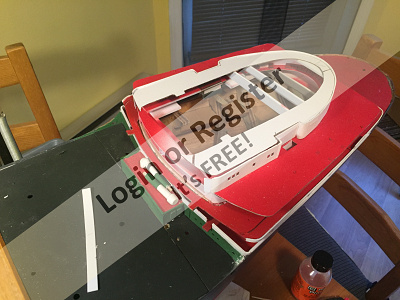Join Us On Social Media!
Scratchbuilt Esso Deutschland 1:150
14 Posts · 9 Followers · 44 Photos · 99 Likes
Began 2 years ago by
Follow This Thread
Not currently following
> Click to follow
> Click to follow
Latest Post 2 months ago by
| Most recent posts shown first (Show Oldest First) | (Print Booklet) |
📝 Superstructure
2 months ago by 🇨🇦 JockScott ( Warrant Officer)
Warrant Officer)
 Warrant Officer)
Warrant Officer)✧ 18 Views · 2 Likes
Flag
💬 Add Comment
Thank you Jumpugly for the kind words. I will try to add more pictures as things are getting a bit easier. I had never done anything in this magnitude, so it is a steep learning curve.
▲
⟩⟩
AlessandroSPQR
jumpugly
Login To
Remove Ads
Remove Ads
📝 Superstructure coming together
2 months ago by 🇨🇦 JockScott ( Warrant Officer)
Warrant Officer)
 Warrant Officer)
Warrant Officer)✧ 20 Views · 3 Likes · 1 Comment
Flag
💬 Add Comment
Made some progress with the superstructure having completed the transition of the removable Bootsdeck. This turned out to be more difficult than thought but with a lot of adjustments and 'building on the fly' so to speak, I think I found the workable solution.
Issues I have found were the different materials. Since I have selected to arbourite for deck material but side walls are styrene. I found some issues with the styrene as it will somewhat deform when too much solvent for the glue is applied. Also I am using .5mm material as I attempting to make the windows appear as in the original (no frame and very small margin in thickness). Fortunately I had some styrene rectangular tubing with the exact inside dimensions to be inserted flush to the wall and paint before applying the window acrylic from the back.





Issues I have found were the different materials. Since I have selected to arbourite for deck material but side walls are styrene. I found some issues with the styrene as it will somewhat deform when too much solvent for the glue is applied. Also I am using .5mm material as I attempting to make the windows appear as in the original (no frame and very small margin in thickness). Fortunately I had some styrene rectangular tubing with the exact inside dimensions to be inserted flush to the wall and paint before applying the window acrylic from the back.





▲
⟩⟩
jumpugly
EdW
AlessandroSPQR
|
💬 Re: Superstructure coming together
2 months ago by 🇺🇸 jumpugly (
 Admiral) Admiral)✧ 23 Views · 2 Likes
Flag
Great workmanship Jock! Coming together beautifully. Don’t know what I’d do without my styrene stash! I use CA on it or the Tamiya thin brush on, just keep the CA away from the window clear. It can haze it.
Keep those pix coming! 👍 ▲
⟩⟩
AlessandroSPQR
JockScott
|
📝 ...some progress
5 months ago by 🇨🇦 JockScott ( Warrant Officer)
Warrant Officer)
 Warrant Officer)
Warrant Officer)✧ 34 Views · 8 Likes · 3 Comments
Flag
💬 Add Comment
Since the last time posting I was at it almost daily but despite my best efforts had very little to show for. However I managed to tackle the inside fo'c's'le bulwark and prepared to openings for the fairleads I did over year ago. In the attempt to achieve a higher degree of an accuracy I keep going back to make adjustments and corrections. I managed to install the aft bridgedeck super structure and glue in next deck level. The sidewalls took some time to paint (still having problems with white paint and required a lot of sanding and redoing). Meanwhile I experimented with building the Anchor chain guide ways. I had to cut individiual supports and glue into the centreline. But eventually I succeeded. I may have to redo some of them as they deformed after glueing and the long guide way from the anchor spill develops a bow not intended. Hope this even itself out once glued to the deck. Although I made up some anchor spills, I tried to replicate the notched grove to fit the chain, I may just redo them again to improve on the appearance. The picture shows them in its raw condition and unpainted.
I have enclosed a few pics to illustrate my story and hope you enjoy reading about my trials and tribulation.
I need to mention that I spent a few weeks in Germany with stays in Hamburg (obligatory visit at the IMM) Berlin, Prag and Dortmund to attend the Inter Modellbau in April. Interesting but I was disappointed about the ships model segment being a bit sparse. Lots of Model rail and R/C trucks.








I have enclosed a few pics to illustrate my story and hope you enjoy reading about my trials and tribulation.
I need to mention that I spent a few weeks in Germany with stays in Hamburg (obligatory visit at the IMM) Berlin, Prag and Dortmund to attend the Inter Modellbau in April. Interesting but I was disappointed about the ships model segment being a bit sparse. Lots of Model rail and R/C trucks.








▲
⟩⟩
LeeA
Len1
EdW
hermank
AlessandroSPQR
Wolle
RNinMunich
jumpugly
|
💬 Re: ...some progress
2 months ago by 🇮🇹 AlessandroSPQR (
 Fleet Admiral) Fleet Admiral)✧ 20 Views · 0 Likes
Flag
I'm really happy to see this work again.
It's one of the most interesting for me. Jock, I'm personally interested in all the construction phases and all the details. Perhaps you learn much more from mistakes than from successes. I'll soon tell you about a very big one I made, due to haste. ▲
⟩⟩
No likes yet
This member will receive 1 point for every like received |
|
Login To
Remove Ads 💬 Re: ...some progress
5 months ago by 🇮🇹 AlessandroSPQR (
 Fleet Admiral) Fleet Admiral)✧ 35 Views · 3 Likes
Flag
Hi Jock, a very welcome and long-awaited return.
You're doing a great job, don't worry if you're making slow progress. ▲
⟩⟩
Len1
JockScott
hermank
|
|
💬 Re: ...some progress
5 months ago by 🇺🇸 jumpugly (
 Admiral) Admiral)✧ 35 Views · 7 Likes
Flag
Jock welcome back! Aye, really like the chain guide and the superstructure work is falling into place nicely. I scraped the whole superstructure except the floors on my freighter and got out the styrene and haven't regretted that move (below). Keep the pix coming when you can...really liking this resto a ton; trials and tribulations included!
👍😉 
▲
⟩⟩
Len1
JockScott
EdW
hermank
AlessandroSPQR
Wolle
RNinMunich
|
📝 Lifeboats and superstructure
10 months ago by 🇨🇦 JockScott ( Warrant Officer)
Warrant Officer)
 Warrant Officer)
Warrant Officer)✧ 46 Views · 8 Likes
Flag
💬 Add Comment
In my exercise in model build learning, experimenting with ideas and realizing it won't work, discovering what works and what doesn't, my patience and endurance gets tested to the limit. In that context and with the inspiration of Alessandro's post about lifeboats, I dared to try again, with new ideas, and renewed my attempt to come up with a way to create the lifeboats in the shape I wanted. I cut out the 'blanks" for the 2 halves and rough shaped them on the sander and refined by hand with sand paper and files. The first attempt seems it is working.
As so often I will put aside one object when I am not happy with the result and go to something else only to go back days later when I have 'recovered' from my 'defeat' and recharged with new ideas.
This what happened the last few days. I see the way forward for the lifeboats clear in my mind and went back to my attempt to fit the handrails (cause of much frustration) for the poop deck superstructure. I am now satisfied I have found the workable solution



As so often I will put aside one object when I am not happy with the result and go to something else only to go back days later when I have 'recovered' from my 'defeat' and recharged with new ideas.
This what happened the last few days. I see the way forward for the lifeboats clear in my mind and went back to my attempt to fit the handrails (cause of much frustration) for the poop deck superstructure. I am now satisfied I have found the workable solution



▲
⟩⟩
LeeA
EdW
hermank
Wolle
RNinMunich
jumpugly
AlessandroSPQR
Ronald
📝 Surgery Break
11 months ago by 🇨🇦 JockScott ( Warrant Officer)
Warrant Officer)
 Warrant Officer)
Warrant Officer)✧ 55 Views · 5 Likes · 1 Comment
Flag
💬 Add Comment
I had to have a cancerous kidney removed. Surgeon is confident he got it all and I should be able to finish the model 🤔 which requires at least another 5 years.
▲
⟩⟩
Commodore-H
hermank
RNinMunich
AlessandroSPQR
jumpugly
|
💬 Re: Surgery Break
11 months ago by 🇺🇸 jumpugly (
 Admiral) Admiral)✧ 58 Views · 4 Likes
Flag
Good news Jock! Yet, anything invasive is a big job. Lay low and heal for a bit. It’s good to have that project to jump back into. It’ll aid in recovery; worked for me every time!
👍😉 ▲
⟩⟩
hermank
jbkiwi
JockScott
AlessandroSPQR
|
📝 Paint issues
11 months ago by 🇨🇦 JockScott ( Warrant Officer)
Warrant Officer)
 Warrant Officer)
Warrant Officer)✧ 70 Views · 4 Likes · 3 Comments
Flag
💬 Add Comment
I have seen Krylon in the stores and certainly will give it a try. I have to give it a rest for a few days as I have to into surgery tomorrow.
▲
⟩⟩
hermank
Peejay
AlessandroSPQR
jumpugly
|
💬 Re: Paint issues
11 months ago by 🇩🇪 RNinMunich (
 Fleet Admiral) Fleet Admiral)✧ 67 Views · 3 Likes
Flag
GWS Jock🤞
Stiff upper lip old chap😐 😎 ▲
⟩⟩
hermank
JockScott
Peejay
|
|
Login To
Remove Ads 💬 Re: Paint issues
11 months ago by 🇮🇹 AlessandroSPQR (
 Fleet Admiral) Fleet Admiral)✧ 73 Views · 4 Likes
Flag
Hi Jock, I hope it's nothing serious.
Happy recovery and good luck. ▲
⟩⟩
hermank
Peejay
Mike Stoney
DuncanP
|
|
💬 Re: Paint issues
11 months ago by 🇺🇸 jumpugly (
 Admiral) Admiral)✧ 73 Views · 5 Likes
Flag
Stay looped in and best wishes on a solid surgery and speedy recovery Jock!
👍 ▲
⟩⟩
hermank
Peejay
Mike Stoney
DuncanP
AlessandroSPQR
|
📝 Paint issues
11 months ago by 🇨🇦 JockScott ( Warrant Officer)
Warrant Officer)
 Warrant Officer)
Warrant Officer)✧ 70 Views · 8 Likes · 1 Comment
Flag
💬 Add Comment
Thank you Alessandro.
Having advanced to the first Deck structure I had already cut out the deck material from Arborite. For you Modellers a very unusual choice but I like its finish, hardness
and virtually indestructibity. When I did the back (foc'sal), midships, main and poop (aft) decks the Tamiya paint, I had chosen for colour preference, not adhering and easily chipping off. I then painted all decks with standard Hardware shop spray paint first and second the Tamiya on top which worked great.
I tried the same when finishing the styrene deck walls for the first deck (white) but noticed the regular spray paint seems to react with the styrene giving it a rubbery feel
and in some places. After sanding it and reapplying I wasn't at all satisfied with the result. As I couldn't get Tamiya white in the rattle can bought Revell acrylic with disastrous effect. The paint's texture seem to become mottled although I had sanded all surfaces. Does anybody have any experience with painting Styrene. I also can't find Tamiya white at my local stores and I am not sure using the Revell. I could resand everything and try the Revell again since I already have otherwise I need to find Tamiya
somewhere else around town.






Having advanced to the first Deck structure I had already cut out the deck material from Arborite. For you Modellers a very unusual choice but I like its finish, hardness
and virtually indestructibity. When I did the back (foc'sal), midships, main and poop (aft) decks the Tamiya paint, I had chosen for colour preference, not adhering and easily chipping off. I then painted all decks with standard Hardware shop spray paint first and second the Tamiya on top which worked great.
I tried the same when finishing the styrene deck walls for the first deck (white) but noticed the regular spray paint seems to react with the styrene giving it a rubbery feel
and in some places. After sanding it and reapplying I wasn't at all satisfied with the result. As I couldn't get Tamiya white in the rattle can bought Revell acrylic with disastrous effect. The paint's texture seem to become mottled although I had sanded all surfaces. Does anybody have any experience with painting Styrene. I also can't find Tamiya white at my local stores and I am not sure using the Revell. I could resand everything and try the Revell again since I already have otherwise I need to find Tamiya
somewhere else around town.






▲
⟩⟩
hermank
Wolle
Peejay
DuncanP
Mike Stoney
EdW
AlessandroSPQR
jumpugly
|
💬 Re: Paint issues
11 months ago by 🇺🇸 jumpugly (
 Admiral) Admiral)✧ 73 Views · 4 Likes
Flag
Hey there Jock! Fantastic hull, I only hope my American Scout can be as smooth!
On styrene I'd give the Krylon Fusion line a shot. Smells to high heaven, but drys hard with a high gloss...will require multiple light coats as opposed to the Rustoleum line of Painter's Touch paints which cover well in one shot. I am a fan of the Tamiya paints, but not of the Testors spray paints, although they do have decent coverage. It's the least they can do considering the can size. As per usual, always do test strips and let everything gas out completely. Any gloss clear top coats should be tested on whatever you use to avoid any horrible unforeseen mishaps. Remember, if you think it's dry, it's not. ▲
⟩⟩
hermank
Peejay
AlessandroSPQR
JockScott
|
📝 Port Hole installation
11 months ago by 🇨🇦 JockScott ( Warrant Officer)
Warrant Officer)
 Warrant Officer)
Warrant Officer)✧ 72 Views · 8 Likes · 1 Comment
Flag
💬 Add Comment
Since my Summer break, I have been working on the aft superstructure. Before I can proceed I have to finalize the porthole. I was unable to find anything I could use on the model supply market suitable as the port holes on the original are flush with the hull and just the window recession. To simulate I thought to drill the holes in the 1mm siding with the acrylic glued in place. This imposed problems as I found out as there is not much space to properly place the acrylic and secure in place. Next option was to construct port holes from alu tubing, filed and sanded to 1mm thickness. I used a tool to cut 3mm holes in leather belts to cut out the acrylic windows which I superglued to the back of the port hole frames. As some drill holes were not quite properly aligned, I had to drill them I bit larger to adjust position and for that expanded the porthole frames with a larger ring of aluminum tubing into which the smaller ring with the acrylic window would fit. A tedious operation with many duds redoing numerous pieces. I had to strengthen some of the siding when the larger port holes didn't leave much material in between. After many attempts, failures and frustration I managed to get them to the point I was finally able to move on to the next stage.
More to come shortly




More to come shortly




▲
⟩⟩
hermank
Wolle
Peejay
Mike Stoney
DuncanP
EdW
jumpugly
AlessandroSPQR
|
💬 Re: Port Hole installation
11 months ago by 🇮🇹 AlessandroSPQR (
 Fleet Admiral) Fleet Admiral)✧ 73 Views · 4 Likes
Flag
Hi Jock, I'm very happy that you continued the work on this model.
I love that you updated us on your progress. This account is very informative. ▲
⟩⟩
hermank
Peejay
DuncanP
JockScott
|
📝 Ballast Question
2 years ago by 🇨🇦 JockScott ( Warrant Officer)
Warrant Officer)
 Warrant Officer)
Warrant Officer)✧ 85 Views · 4 Likes · 2 Comments
Flag
💬 Add Comment
Alessandro, if I will sail the model how have I intended it remains to be seen. Definitely I'll start in Ballast condition, then try loaded as planned. If everything goes as hoped I will subject it to water dousing. If it proves to keep the water out I will go further. One tiny step at a time
▲
⟩⟩
Peejay
hermank
Len1
AlessandroSPQR
|
💬 Re: Ballast Question
2 years ago by 🇮🇹 AlessandroSPQR (
 Fleet Admiral) Fleet Admiral)✧ 81 Views · 4 Likes
Flag
More than right, Jock.
I look forward to enjoying the developments of ESSO Deutschland. ▲
⟩⟩
Peejay
Len1
hermank
JockScott
|
|
💬 Re: Ballast Question
2 years ago by 🇺🇸 LewZ (
 Vice Admiral) Vice Admiral)✧ 87 Views · 5 Likes
Flag
When I use ballast I keep it simple. I don't generally use strict calculations as to ballast density, just approximate, so that the ballast is underweight. Then add trim ballast. Do a test run first. Fill some plastic bags with dirt/sand, or ? to see what it takes to trim the boat, then work out the amount of ballast you need. Kind of like using a balance scale to weigh something. Put the item on one side then start adding weights to the other side. Common sense will tell you what to do and what materials to use, depending on what is available, cost and effectiveness.
I add ballast to have the boat float evenly at or slightly above the waterline. This is done in a tub, usually outdoors. when there is no wind blowing. As a boat will not usually float evenly (fore-aft and/or port-starboard) when completed, several locations for ballast might be warranted. Floating unevenly might be caused by either the details on the boat being not symmetrical or perhaps some off center internal components. One can use fixed ballast or removable ballast, or both. My preference is usually removable ballast as who knows what changes might be added or removed in the future. For heavier boats both fixed and movable might be a good choice. The movable ballast is usually for trimming and fine tuning. The most common type of ballast I use is usually non-rusting metal. What kind of ballast material depends on the amount I need and the size of the boat, and of course how much volume is available as well as the shape. Again, here is where common sense into play. We all know that the ballast should be added at the lowest point(s) available. That could define the overall shape of the ballast. IMPORTANT: For better stability keep the ballast as low as possible. So, here are some examples: SMALL BOATS: (Boats generally under ~20".) Here the ballast is usually minimal in amount needed and placed into small spaces. BBs, small ball bearings (balls only), hardware (nuts, washers, etc.). MEDIUM BOATS (~20-35".) More freedom of ballast locations allow a larger variety of materials. Perhaps a mixture of materials depending on if it is fixed or removable. LARGE BOATS: (>~35".) Here is where cement (concrete) might come into play as well as other options for inexpensive materials including water itself. TIPS: 💡 I had a large barge I wanted to trim out to about 100 pounds (45 kg). I brought some empty plastic soda bottles with me and filled them at the pond. Then I placed them inside the barge (photo) along with some bricks after it was in the water. 💡One of the SSMBC members has a "whaleback freighter" and uses a pump to add ballast after launching. Pumps it back out before lifting it out of the water when done. 💡 Coins. Here is the US the common copper penny can be used. Its inexpensive and stacks very well into a tubular shape. 💡 Velcro is a handy way of holding a ballast box in place. 💡 Many times I will make a 3D printed box and fill it with a ballast material and seal it. Often this is attached with Velcro. 💡 Cement (concrete) works just fine. I recommend "casting" it in a container which is the shape you want. Let it cure well (a week?) then paint it with several coats. I used urethane varnish. The best concrete to use is the kind without aggregate (powder only). The better the finish on your casting box is the better the finish on the ballast will be. I personally would not pour the concrete directly into the hull. Note that these are just suggestions and can vary depending on the type of boat you have. Hope this helps. Lew Florida 😎, USA 
▲
⟩⟩
Wolle
Peejay
DuncanP
hermank
Len1
|
📝 Ballast Question
2 years ago by 🇨🇦 JockScott ( Warrant Officer)
Warrant Officer)
 Warrant Officer)
Warrant Officer)✧ 88 Views · 4 Likes · 1 Comment
Flag
💬 Add Comment
I agree with everything you brought up. I have to, however, consider practicality. While lead may be the best medium for its weight/volume density, not having any foundry facility, it also imposes inherent difficulties to achieve maximum space utilization.
Cement has specific weight of 3.16 to water, I could enhance this by adding gravel but with limited benefit.
Once I get to the point of putting my model to water, I will do some testing how much weight I really need. I can do some quick calculations how much I will need and have the option with the smaller compartments to achieve ideal balance.
When running 'in ballast' I will have a small acid/lead battery (those for motor bikes) in the aft section to get proper draft (I hope).
I surely let you know once I get there.
Cement has specific weight of 3.16 to water, I could enhance this by adding gravel but with limited benefit.
Once I get to the point of putting my model to water, I will do some testing how much weight I really need. I can do some quick calculations how much I will need and have the option with the smaller compartments to achieve ideal balance.
When running 'in ballast' I will have a small acid/lead battery (those for motor bikes) in the aft section to get proper draft (I hope).
I surely let you know once I get there.
▲
⟩⟩
Len1
hermank
Peejay
AlessandroSPQR
|
💬 Re: Ballast Question
2 years ago by 🇮🇹 AlessandroSPQR (
 Fleet Admiral) Fleet Admiral)✧ 88 Views · 3 Likes
Flag
Hi Jock, I see you are very determined about the choice of concrete and the construction phases.
You have already weighed the pros and cons of using concrete so yours is a wise choice. The only doubt I have is on the specific weight of 3.16 kg/dm3. It could be different and it could be less. However, since you have decided to proceed with an empirical method (very effective in this case in my opinion): "Once I get to the point of putting my model to water, I will do some testing how much weight I really need" then establish precisely the specific gravity no longer matters. However, even using concrete (and therefore occupying a much larger volume than a heavy metal) you may still have a lot of space available to create the buoyancy reserve. You only need 34-36 dm3 and I think you could find them anyway. Since it is very easy to create, it costs nothing and since you want to sail the Esso Deutchland on the ocean, I would seriously think about making it unsinkable. I invite you to also consider (but you have certainly already done so) batteries as ballast. Don't limit yourself. In such a large RC model you can easily obtain truly exceptional performance in terms of autonomy. What a great advantage not having to look for light but expensive batteries and instead being able to use heavy and cheap batteries without problems. Even with the empiric method, it is better to immediately achieve the correct longitudinal trim with the two extreme quarters (bow and stern). In this way the addition of weights in the central quarters will have very little influence on the inclination and you will be able to regulate the sinking with greater serenity. "I surely let you know once I get there." Of course I'm counting on it, Jock. As I already told you, your work is one of those that attracts my attention and interest the most. I don't want to spoil too much but I'm curious about the electrical setup. It's not wrong to think about it now. I hope you will put side lights, fog sirens, fog lights and more. One question: How will you navigate your tanker, fully loaded, empty or somewhere in between? ▲
⟩⟩
hermank
Len1
JockScott
|





 Canada
Canada















